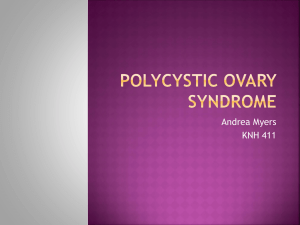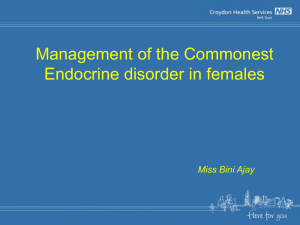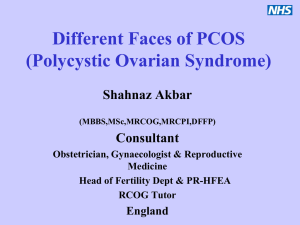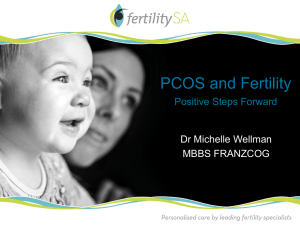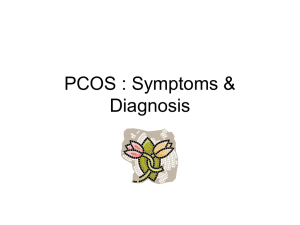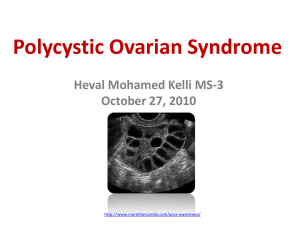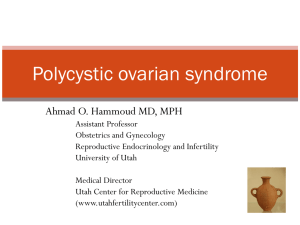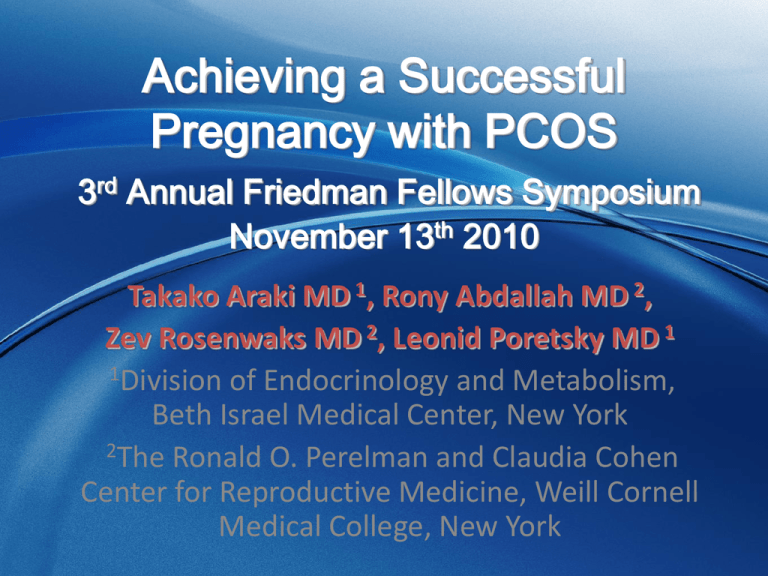
Achieving a Successful
Pregnancy with PCOS
3rd Annual Friedman Fellows Symposium
November 13th 2010
Takako Araki MD 1, Rony Abdallah MD 2,
Zev Rosenwaks MD 2, Leonid Poretsky MD 1
1Division of Endocrinology and Metabolism,
Beth Israel Medical Center, New York
2The Ronald O. Perelman and Claudia Cohen
Center for Reproductive Medicine, Weill Cornell
Medical College, New York
Polycystic Ovary Syndrome (PCOS)
• PCOS is characterized by anovulation,
hyperandrogenism, and polycystic ovarian
morphology.
• PCOS was initially described by Stein
Leventhal in 1935.
• Prevalence : 7-8% of reproductive age women
• PCOS is the most common cause of infertility
in reproductive age women
Clinical Manifestations of PCOS
• Peripubertal onset
• Cutaneous :
–
Hirsutism, Acne, Male pattern baldness
• Reproductive :
–
Amenorrhea/Oligomenorrhea, Infertility, Early
pregnancy loss
• Metabolic :
–
Obesity, Insulin resistance, type2 diabetes (10%
by age 40s), and cardiovascular disease
Biochemical Manifestations of PCOS
• Elevated total/free testosterone,
androstenedione, progesterone,
dehydroepiandrosterone sulfate (DHEAS),
• Decreased sex hormone binding globulin
(SHBG)
• Increased insulin levels
• Elevated LH/FSH ratio.
Diagnostic Criteria
• NIH Criteria 1990
• Rotterdam Criteria 2003
• Androgen Excess and PCOS Society Criteria
2006
None of the criteria addressed insulin
resistance and metabolic manifestations
• NIH (1990)
Anovulation or oligo-ovulation
Clinical and/or biochemical hyperandrogenism
• Rotterdam (2003) (Two out of three)
Anovulation or oligo-ovulation
Clinical and/or biochemical hyperandrogenism
Polycystic ovaries (morphology)
• Androgen Excess and PCOS Society (2006)
Ovarian dysfunction (either)
Anovulation or oligo-ovulation
Polycystic ovaries (morphology)
Clinical and/or boichemical hyperandrogenism
Etiology/Hypotheses of PCOS
• Central Hypothesis (1,2) : abnormal GnRH pulse can ↑LH pulse
amplitude and frequency, and change ratio of LH/FSH
• Ovarian Hypothesis (3,4) : Intrinsic ovarian functional defects of
theca cells(P450c17) and granulosa cells (aromatase)
• Adrenal Hypothesis (5,6,7) : Increased androgen production
during puberty can decrease FSH production → stimulate
ovarian hyperandrogenism
• Dual-defect (8) : Two independent defects; elevated LH and
hyperinsulinemia can cause synergetic action in the ovary
• Programming (9,10) : Intrauterine hyperinsulinemia and
hyperandrogenemia can program female reproduction and
possibly produce a phenocopy of PCOS
• Genetic (11,12,13) : PCOS has strong familial clustering
Insulin related ovarian regulatory system
Poretsky, L., et al., Endocr Rev, 1999. 20(4): p. 535-82.
Synergistic effect of Insulin and
LH/hCG on ovarian growth
Poretsky, L., et al., Endocr Rev, 1999. 20(4): p. 535-82.
Treatment of infertility in PCOS
• Lifestyle Modification
• Medical Therapy
– Clomiphene citrate
– Gonadotropin/GnRH
– Metformin
– Thiazolidinediones
– Glucagon-like peptide-1 agonists
• IVF/IVM
Lifestyle Modification
• Weight loss (5-10% over 6 months) is effective
in re-establishing ovarian function in >50% of
obese PCOS women.
Study
1995
Weight loss
6.3 kg
Outcomes
12 out of 13 + ovulations
11 out of 13 + pregnant
Hollman 1996
5.6 kg
80% ovulation rate
29% pregnancy
androstenedione, insulin
testosterone, estradiol
Huber-Buckholz 1999
6.3 kg (2-5% loss)
9 out of 15 + ovulations
2 out of 15 + pregnant
Hoeger 2004
6.8% loss
30% increased ovulation rate
Decreased hirsutism score
Clomiphene Citrate
• Clomiphene is a partially selective estrogen
receptor modulator.
• Induces a change in GnRH pulse frequency,
increases FSH level, promotes follicular
development
• Used for ovulation since 1960s
• High ovulation rate (60-85%), 30-40%
pregnancy rate
Clomiphene Citrate
• 4-10% risk of ovarian hyperstimulation
syndrome (OHSS)
• There is a discrepancy between ovulation rate
and pregnancy rate.
• Obese PCOS women tend to have clomiphene
resistance.
• Clomiphene is the current first-line therapy
(Thessaloniki ESHRE/ASRM consensus 2008).
Gonadotropin/GnRH
• Human recombinant FSH is the often used
preparation
• High ovulation rate (70%) and pregnancy rate
(30%)
• Risk of multiple pregnancies (25-30%) and OHSS
• Step-up low dose FSH induction protocol has been
safer for monofollicular development; decreased
risk of OHSS with same ovulation rate and
pregnancy rate compared to high initial dose FSH
protocol.
Gonadotropin/GnRH
• Current recommendation – start from low
dose of FSH (37.5-50.0 IU daily) with step-up
regimen (Thessaloniki ESHRE/ASRM 2008).
• Gonadotropin therapy is high cost, needs
frequent monitoring of estradiol levels and
sonographic follow up.
Metformin
• Insulin sensitizers target metabolic abnormalities to
improve ovulation and fertility in PCOS women.
• Metformin is a category B drug for pregnancy
• Metformin enhances AMPK pathway, increases
IGFBP-1 level; no evidence of anti-inflammatory
effects.
• Initial study was done by Velazquez in 1994, which
showed increased pregnancy rate.
• Numerous studies have been conducted with
inconclusive data of metformin as the first therapy
until mid 2000s.
Metformin vs. Clomiphene
• Metformin or Clomiphene, inconclusive which
would be the first-line therapy
Total N
duration
ovulation
Rate
pregnancy
rate
Palomba
2005
102
Lean PCOS
6 months
M=C
M>C
Neveu 2007
154
All PCOS
9 months
M>C
M=C
Legro 2007
626
All PCOS
6 months
M=C
Zain 2009
115
Obese PCOS
6 months
M=C
M=C
Baran 2010
61
Obese PCOS
3 months
M<C
M=C
live birth
M << C
M<C
M : metformin, C : clomiphene
Live Birth Prediction
Basic clinical information can predict live birth rate with either
metformin, clomiphene, or combination (14)
Rausch, M.E., et al. J Clin Endocrinol Metab, 2009. 94(9): p. 3458-66.
Thiazolidinediones (TZDs)
• TZDs are PPAR-γ ligands used as insulin
sensitizers
• In human ovary, TZDs directly inhibit ovarian
androgen production by regulating ovarian
steroidogenic enzymes
• TZDs also stimulate StAR protein, 3β HSD, and
inhibit aromatase
Thiazolidinediones (TZDs) (cont’)
• Several studies showed that troglitazone
improved insulin resistance and ovulation,
however it was removed from the market
because of hepatotoxicity
• Rosiglitazone/Pioglitazone improve ovulation,
however there is concern about
cardiovascular risk
• TZDs do not cause weight loss
• TZDs are pregnancy category C drugs
Glucagon-like peptide-1 (GLP-1) agonists
• GLP-1 is an incretin hormone derived from GI tract
• GLP-1 enhances glucose-dependent insulin
secretion, delays gastric emptying
• GLP-1 controls central appetite stimulation,
therefore induces weight loss
• A pilot study showed that GLP-1 improved ovulation
(50%), produced moderate weight loss, and
decreased testosterone levels (15)
• GLP-1 agonists may have a role to play in the
treatment of PCOS
In-vitro fertilization (IVF)
• Indication: Failure of non-pharmacologic and
clomiphene citrate treatment+ failure of
Gonadotropin/IUI
• High success rate of pregnancies, however,
women with PCOS tend to be hypersensitive
to gonadotropin therapy, therefore have an
increased rates of multiple pregnancies and
OHSS.
• The clinical pregnancy and implantation rates
in PCOS women are 30-35% and 10-15%,
respectively .
In-vitro fertilization (IVF)
• Numerous IVF/induction protocols have been
attempted to decrease OHSS.
• Damario et al presented data of dual pituitary
suppression therapy to normalize LH/FSH ratio
with significant decrease of OHSS (16) .
In-vitro maturation (IVM)
• Since multifollicular development is the goal of
ovarian stimulation for IVF, PCOS patients often
present therapeutic challenge.
• With in vitro maturation (IVM), immature
follicules are collected, then matured in the
laboratory before being fertilized.
• Compared to IVF, IVM requires less ovarian
stimulation, therefore decreases risks of OHSS.
Risks of PCOS
•
•
•
•
•
•
•
Early pregnancy loss
Gestational diabetes
Pregnancy-induced hypertension and preeclampsia
Birth weight (low or high)
Risk of PCOS for female offspring
Risk of metabolic disorders for offspring
Metabolic/cardiac complications for male offspring
Early pregnancy loss (EPL)
• 3 times higher risk in PCOS
(30-50% in PCOS vs. 10-15% in control)
• Obesity and hyperinsulinemia are
independent risk factors of EPL
• Mechanism is unclear: possibly, ↓glycodelin,
↓IGFBP-1, ↑plasminogen activator inhibitor1 maybe associated risks
• A few studies showed that metformin
decreases the risk of early pregnancy loss (17)
Gestational diabetes (GDM)
• Higher risk in PCOS women
– 40% in PCOS vs. 4% in control
• Insulin resistance created by changes in
diabetogenic hormones during pregnancy (hPL,
estrogen, progesterone) as well as baseline
insulin resistance - a feature of PCOS
• Risk of GDM is independent of obesity
• Metformin appears to reduce the occurrence
of GMD (18)
Pregnancy-induced hypertension and
preeclampsia (PIHDs)
• Likely the risk factor of PIHDs
– 14% in PCOS vs. 2.5-5% in control
• Underlying hyperinsulinemia appears to be an
independent risk factor for PIHDs (19)
• A recent pilot study demonstrated that continuous
use of metformin may reduce risk of PIHDs
Birth weight
• Birth weight of offspring of PCOS women has
been controversial
• Low birth weight has been associated with the
development of type 2 diabetes and
cardiovascular disease
• Numerous studies support the finding that
offspring of women with PCOS tend to have low
gestational weight
• However, a recent meta-analysis and a large
family study showed there is no difference in
birth weight effect between the offspring from
PCOS and controls
Risk of PCOS for female offspring
• Female offspring of PCOS women may have a higher
risk of developing PCOS
• Prenatally androgenized female monkeys exhibit 4050% fewer menstrual cycles than normal females,
and 40% have polyfollicular ovaries that resemble
the morphology of PCO (20) .
• In a human cross-sectional study, PCOS daughters
exhibited ↑LH and ↑testosterone,
hyperinsulinemia, and ↑ovarian size during puberty
(21) .
Risk of metabolic disorders for offspring
• Offspring of PCOS mothers tend to have metabolic
abnormalities in their later life.
• Prenatally androgenized female monkeys develop
metabolic problems characteristic of women with
PCOS (↓insulin sensitivity, ↓beta cell function,
↑total body adiposity)
• Offspring of the early-treated female monkeys
exhibited impaired insulin secretion while those of
the late-treated females showed ↓insulin
sensitivity and ↑adiposity, but preserved insulin
secretory function.
Metabolic/cardiac complications for
male offspring
• Male offspring from PCOS women have
phenotypes which include ↑hair growth,
premature male balding.
• There is strong evidence that male offspring
appear to have high risk of metabolic
derangements, including type 2 diabetes,
dyslipidemia, and risk of cardiovascular
disease.
Metabolic/cardiac complications for
male offspring (Cont’)
• Adult male rhesus monkeys exposed to
testosterone in-utero exhibit insulin resistance
and impaired insulin secretion (22) .
• A recent study of male offspring of PCOS
women found that, compared to control,
there was an increase in body wt beginning in
early infancy (2-3 months), which persisted
into adulthood; insulin resistance developed
during adulthood (23) .
Genetics/genetic counseling in the
future
• PCOS has strong familial clustering, therefore
a genetic etiology is suspected.
• Lack of reliable associations between
genotype and phenotype raises the possibility
that inheritance of PCOS, if any, is modified by
environmental factors.
Genetics/genetic counseling in the
future
• The strongest evidence of an association of a
single gene with PCOS is for nucleotide repeat
microsatellite marker D19S884 within intron
33 of the fibrillin-3 gene, however, it is not
clear whether on how Fibrillin-3 contributes to
the pathogenesis of PCOS (23) .
• Like in other complex diseases, including
diabetes, genetic research in PCOS remains
challenging and confounded by extreme
heterogeneity of PCOS.
Conclusions
• PCOS is a disease of multiple etiologies and variable
phenotypes.
• Infertility may be present. A variety of methods has
been used successfully to achieve pregnancy in
women with PCOS.
• Maintenance of pregnancy is complicated by higher
rate of premature spontaneous abortions, risk of
gestational diabetes and preeclampsia.
• With careful treatment and monitoring, today the
majority of PCOS women can have successful
outcome of their pregnancy.
1.
2.
3.
4.
5.
6.
7.
8.
9.
10.
11.
12.
13.
14.
15.
References
Morales, A.J., et al., J Clin Endocrinol Metab, 1996. 81(8): p. 2854-64
Berga, S.L., J Clin Endocrinol Metab, 1993. 77(4): p. 895-901
Gilling-Smith, C., et al., Clin Endocrinol (Oxf), 1997. 47(1): p. 93-9
Pierro, E., et al., Hum Reprod, 1997. 12(9): p. 1890-6
Ibanez, L., et al., J Clin Endocrinol Metab, 1993. 76(6): p. 1599-603
Ibanez, L., et al., Fertil Steril, 1997. 67(5): p. 849-55
Moghetti, P., et al., J Clin Endocrinol Metab, 1996. 81(3): p. 881-6
Poretsky, L., et al. Obstet Gynecol, 1994. 84(4): p. 613-21
Barker, D.J., Trends Endocrinol Metab, 2002. 13(9): p. 364-8
Abbott, D.H., et al., Hum Reprod Update, 2005. 11(4): p. 357-74
Givens, J.R., Endocrinol Metab Clin North Am, 1988. 17(4): p. 771-83
Hague, W.M., et al., Clin Endocrinol (Oxf), 1988. 29(6): p. 593-605
Legro, R.S., et al., Proc Natl Acad Sci U S A, 1998. 95(25): p. 14956-60
Rausch, M.E., et al. J Clin Endocrinol Metab, 2009. 94(9): p. 3458-66
Elkind-Hirsch, K., et al. J Clin Endocrinol Metab, 2008. 93(7): p. 2670-8
16. Damario, M.A., et al., Hum Reprod, 1997. 12(11): p. 2359-65
17.
18.
19.
20.
21.
22.
23.
24.
Glueck, C.J., et al. Fertil Steril, 2001. 75(1): p. 46-52
Glueck, C.J., et al.Fertil Steril, 2002. 77(3): p. 520-5
Hamasaki, T., et al. Int J Gynaecol Obstet, 1996. 55(2): p. 141-5
Abbott, D.H., et al. Hum Reprod Update, 2005. 11(4): p. 357-74
Sir-Petermann, T., et al., J Clin Endocrinol Metab, 2009. 94(6): p. 1923-30
Norman, R.J., et al., Fertil Steril, 1996. 66(6): p. 942-7
Recabarren, S.E., et al., J Clin Endocrinol Metab, 2008. 93(5): p. 1820-6
Ewens, K.G., et al., J Clin Endocrinol Metab, 2010. 95(5): p. 2306-15

